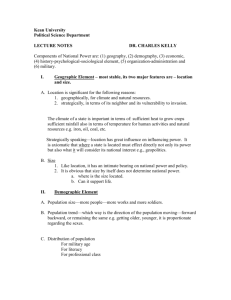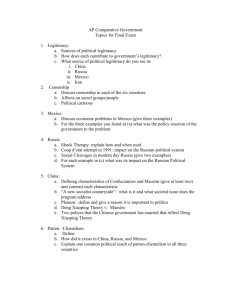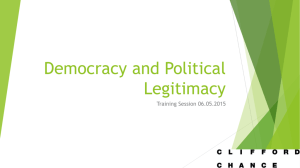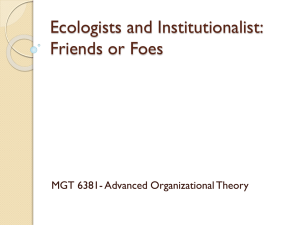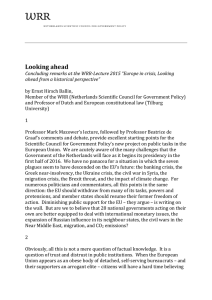DRAFT ASEAN PLUS THREE: PROCESS AND PERFORMANCE LEGITIMACY Richard Stubbs
advertisement
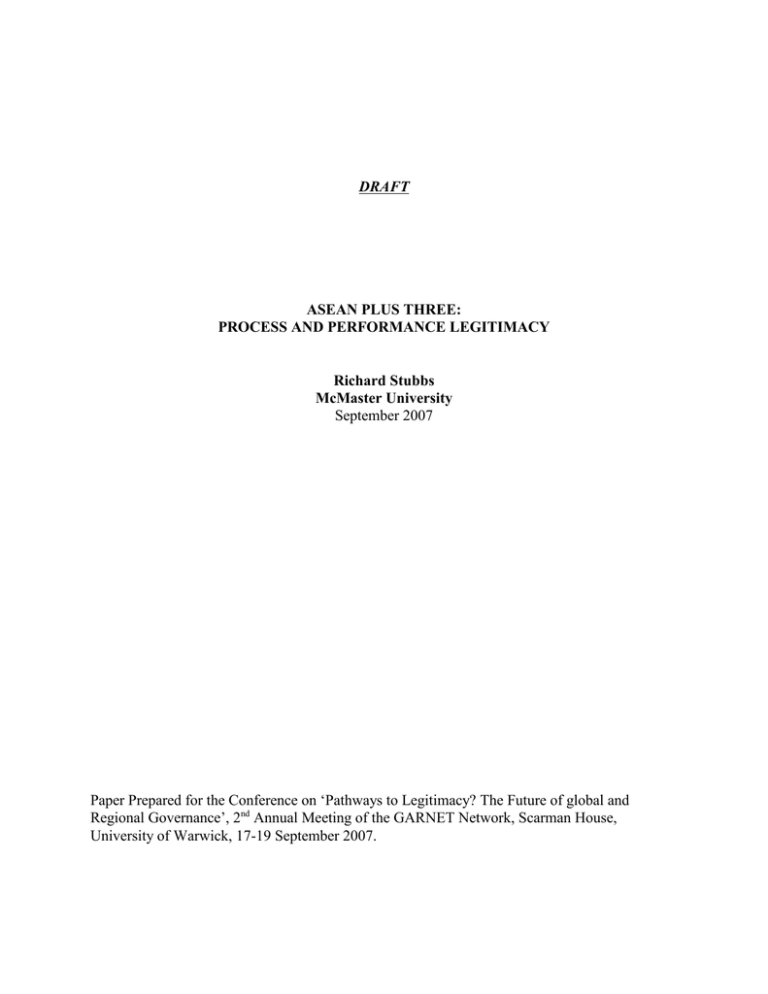
DRAFT ASEAN PLUS THREE: PROCESS AND PERFORMANCE LEGITIMACY Richard Stubbs McMaster University September 2007 Paper Prepared for the Conference on ‘Pathways to Legitimacy? The Future of global and Regional Governance’, 2nd Annual Meeting of the GARNET Network, Scarman House, University of Warwick, 17-19 September 2007. DRAFT DRAFT DRAFT ASEAN PLUS THREE: PROCESS AND PERFORMANCE LEGITIMACY Richard Stubbs McMaster University September 2007 The question that this paper seeks to address is: To what extent has the ASEAN Plus Three (APT) process or framework gained legitimacy over the first ten years of its existence? The term ‘legitimacy’ has a long and distinguished history and can be interpreted in many different ways. Generally legitimacy may be thought of as the obligation to obey decisions made by a particular political institution. Most often in the past these political institutions have been states. However, increasingly, as states have had to share decision-making with other forms of authority, discussions of legitimacy have broaden out. In other words, sources of legitimacy other than state officials need to be considered. Moreover, It is possible to think in terms of input or process legitimacy in which people feel a sense of obligation to obey the decisions made by a particular political entity because those making the decisions have the right to do so. That is to say those who have reached the positions in which they make decisions that others are expected to accept have arrived at their posts in ways that are considered legitimate. However, it is also possible to think in terms of output or performance legitimacy in which people agree to obey decisions because they believe the decisions themselves to be generally beneficial to the general population. For many people this comes down to whether those making the decisions are providing physical security, social and political stability and economic prosperity at the levels deemed acceptable. Just like most other political institution, then, the APT framework has the possibility of drawing on multiple sources for its legitimacy (Alagappa 1995; Scharpf 1999; Skogstad 2003). This paper is divided into two main sections. The first section sets out the possible sources from which an institution like APT can expect to draw legitimacy. The second section examines the development of the APT framework, evaluates the sources of both input or process legitimacy and output or performance legitimacy and provides a brief conclulsion. Sources of Legitimacy Fritz Scharpf (1999: 12) makes the point that in democratic states ‘input-oriented and 1 output-oriented legitimacy co-exist side by side, reinforcing, complementing, and supplementing each other’. However, there would appear to be no reason why this cannot be said of all forms of political institutions. In other words, input or process legitimacy and output or performance legitimacy are two dimensions of the multiple forms of legitimacy that are generally associated with all forms of political authority. Indeed, each of these forms - input and output legitimacy - may be further broken down into multiple sources of legitimacy. In order to appreciate the many different forms of legitimacy, then, it is worthwhile reviewing some of the approaches that others have taken. For example, in Europe the right to rule, has over the centuries, been viewed in various ways. Some have argued that a ruler had to be obeyed because he or she was chosen by divine authority. Obedience to the ruler was, therefore, obedience to God’s law. Others argued that political authority rested with those who could muster the most coercive power and thus maintain civil stability. In his analysis of the issue Weber added to this list of the sources of legitimacy. He argued that political authority could be vested in a ruling family, who continuously ruled over time and, therefore acquired traditional authority; charismatic leaders, who had exceptional personal characteristics; or in a legal-bureaucratic or legal-rational system in which authority emanated from the political office not from the individual who held office (Weber 1947). Importantly, Weber acknowledged that none of these forms of political authority existed in pure form. Other scholars have reviewed the concept of political authority and come up with another set of sources of authority and legitimacy. For example, Grace Skogstad, (2003) in her 2003 Presidential Address to the Canadian Political Science Association, argues that there are four sources that may be identified as legitimate in terms of the exercise of authority. First, there is state-centred political authority which essentially means elected state officials and the bureaucrats who run government departments. Elected officials, of course, enjoy legitimacy through the process by which they arrive at their positions of authority. While this group in clearly very significant, as Skogstad (2003: 965) points out, ‘it does not enjoy a monopoly on the legitimate exercise of political authority’. Moreover, confidence in representative democracies across the Western world has been reduced by a number of factors including the pressures from internationalization and globalization, the corrosive impact of ‘money politics’ as elected officials are required to spend more and more on getting out votes, and the lack of transparency in government decision making - especially in bureaucracies - in a world made more open by massive advances in communication technology. The result has been a steady reduction in the percentage of eligible voters going to the polls in many of the more mature democracies. Second, legitimate authority can be exercised by experts. These can range from collections of bankers to members of dispute settlement panels to judges in courts. Increasingly, those with technical expertise of one form or another are called on to use their expertise to decide conflicts or to ensure what Skogtad (2003: 960) refers to as ‘efficacious political outcomes’. In some instances the legitimacy of experts is derived from the fact that they are extensions of the state’s authority and they are given their mandate to perform a specific function by elected officials. But technical experts can also enjoy legitimacy because of the idea that they produce 2 better, de-politicised decisions and so are more likely to enhance the welfare of the whole community. This has certainly been a significant aspect of the neo-liberal paradigm that has been associated with the advances made by the forces of globalization. Economists, bankers and so forth have been called on to make decisions so as to ensure, it is argued - somewhat naively perhaps - that technical rather than political considerations are the basis of decision-making. Third, market-based authority or what some have termed ‘private authority’ has emerged over the last few decades (Cutler, Haufler and Porter 1999). Private actors, Skogstad (2003: 961) points out, ‘can be accepted as legitimate allocators of public values when they have strong incentives to equate their private interests with that of the public or when the public places a high value on efficient policy outcomes’. There are a wide variety of market based authorities ranging from stock markets to a series of self-regulating associations or institutes that govern various aspects of economic or social activities such as the internet or international accounting standards (see eg Eaton and Porter forthcoming; Farrell 2006). In many cases, market based authorities are again simply extensions of state-authority and as such have limited legitimacy outside that which accrues to state-authorities. However, they have become more common in recent years and, therefore, should be taken into consideration. Finally, Skogstad (2003: 962-64) argues that popular authority is increasingly important in that it legitimizes decision making by providing for deliberation and direct public input. Referenda and plebiscites are clearly the most often employed forms of direct democracy although their use can be hotly contested. They are used to decide constitutional issues, such as the referenda on Quebec sovereignty/separation and in some instances in European Union (EU) member countries have voted in referendums on changes to a member’s relationship to the central EU institutions. Some might point to the success of television’s ‘Idol’ competitions in various Western countries as an indication of the support for more direct involvement in authoritative decision making. Although it also has to be noted that the British politician, EU Commission for External Affairs and former Governor of Hong Kong, Chris Patten, has famously argued that ‘referendums are fundamentally anti-democratic in our (British) system’ (‘Breakfast With Frost’, BBC, June 1, 2003). Delineating these different sources of legitimacy indicates the complexity of the links between political authority and legitimacy. A further complication is presented by the division between process or input legitimacy on the one hand and performance or output legitimacy on the other. Clearly, some authoritative institutions such as expert technical bodies can be thought of as having both process and performance legitimacy in that they gain legitimacy from being appointed by a democratically elected body such as a legislature while at the same time they may produce better policies that meet everyone’s needs because of their technical abilities. Moreover, while process legitimacy is generally thought of as more important in Western liberal societies, performance legitimacy can be crucial in some areas of the global South, especially where authoritarian or ‘soft authoritarian’ regimes predominate (Stubbs 2001). Perhaps as a consequence, performance legitimacy is less well explored than is process 3 legitimacy. As a way of coming to grips with the various forms of performance legitimacy it is possible to make use of categories first developed by Walter Bagehot in the context of his discussion of various aspects of the British constitution. Bagehot wrote about what he saw as the ‘efficient’ and ‘dignified’ aspects of the constitution and this division can also be applied to the notion of performance legitimacy (Bagehot n.d.: 63-70). The ‘efficient’ aspect may be thought of as the ‘task’ or ‘instrumental’ dimensions of performance legitimacy in that concrete problems are solved or particular issues - such as increased prosperity or economic development, social stability, and physical security for the state and individuals - are successfully addressed. enhanced. to talk in terms of task and symbolic forms of output legitimacy. The ‘dignified’ aspects of the constitution may be thought of as essentially the ‘symbolic’ or ‘expressive’ dimensions of performance legitimacy which allude to the extent to which a political institution is able to expression traditional values which resonate with those most influenced by its policies. An important point that comes out of the many ways of cutting into the question of legitimacy is that the mix of the sources of legitimacy that ensure the continued functioning of institutions of political authority is different from country to country. By extension, then, it can be argued that political authority is exercised in different regional organizations based on different mixes of the sources of legitimacy. Hence, for example, the mix of sources of legitimacy that Skogatad identifies as significant for the exercise of political authority in Canada may be quite different to the mix of sources of legitimacy to be found in many countries in say Africa or Asia. Similarly, the mix of sources of legitimacy that has emerged around political institutions in the European Union (EU) is different than those associated with the North American Free Trade Agreement (NAFTA). It is to one such regional organization that this analysis now turns. Legitimacy and the ASEAN Plus Three Regional Grouping The origins of the APT are a significant factor in the emergence of the organization’s legitimacy. First articulated by Goh Chock Tong, the Prime Minister of Singapore, in Paris in October 1994, the idea of an Asia-Europe Meeting (ASEM) was approved by both ASEAN and the European Union by mid-1995. The ASEAN members then asked Japan, China and South Korea to join them as the Asian representatives. There was some reluctance on the part of the Japanese government, which still feared alienating the Americans, and the Chinese government, which worried about being a target of criticism over human rights. Nonetheless, representatives of all three Northeast Asian governments joined their ASEAN counterparts in preliminary meetings during the second half of 1995. At the ASEM in Bangkok the leaders agreed that the process should be continued with a senior officials meeting set for later in 1996, meetings of economic ministers and foreign ministers projected for 1997 and a second ASEM summit planned for London in 1998. Importantly, of course, these meetings meant that representatives of the Asian members of ASEM would need to get together every so often to coordinate their positions on the various issues to be put on the agenda and that they would participate regularly together in various ASEM ministerial meetings. In practical terms this proved to be the catalyst 4 that turned the EAEC into the APT, a functioning, if somewhat embryonic, East Asian regional cooperative arrangement. The first informal summit of the APT leaders was held in association with the ASEAN leaders meeting in Kuala Lumpur in 1997. With the financial crisis of 1997-8 acting to promote cooperation among the APT members, East Asian regional institution-building with ASEAN at its centre began in earnest. As Richard Higgott (1998) has noted, the Asian Financial Crisis produced a wave of resentment at the way that East Asia governments had been treated by the US and key global governance institutions, notably the IMF. The emerging APT framework was the on regional organization that appeared to provide the means for develop a minimum level of autonomy in the face of the buffeting the region had received from the forces of globalization. The Asian Financial Crisis, then, gave the embryonic APT a major boost at a crucial moment in its evolution. Subsequently, meetings of the APT heads of government took place at each of the following annual ASEAN summits. In addition, various APT ministers, including finance, economic and labour ministers, as well as officials from a number of ministries started meeting regularly. Indeed, according to Musa Hitam, the Chairman of the Eminent Person’s Group, which recently made the recommendations for an ASEAN Charter, there are over 700 ASEAN meetings per year, a substantial percentage of which also include representatives from the Plus Three Group (Hong 2007: 24). Out of the origins and early development of the APT come two points that are especially significant for this analysis. First, initial expectations for the APT among its members were relatively low. The idea of negotiating with the EU through the medium of a biennial ASEM was seen as a useful exercise politically but its chances of producing any major economic benefits were seen as relatively slim. Therefore, there was little expected of the Asian caucus of ASEM as it began to evolve into the APT framework. Similarly, as the APT emerged from the Asian Financial Crisis expectations were similarly low. Neither APEC nor ASEAN had been of much assistance during the Crisis and so while some hopes were vested in the APT that it might help to manage the negative effects of globalization they were not inordinately excessive. Second, the APT was not exactly starting from scratch. It was in many respects an outgrowth of ASEAN and so had a relatively easy launch. In this sense while the were certainly questions about ASEAN’s role and viability its extensive institutional structure meant that the APT was able to build in an existing and reasonably well developed framework of operations. The APT essentially has two sources of process or input legitimacy. First, is the legitimacy associated with state-centred political authority. Obviously, the governments of the member states have themselves gained legitimacy to varying degrees and in varying ways. For example, the Burmese government’s legitimacy is tenuous at best. The Philippines has had a democratic government since the People’s Revolution of 1986 while both South Korea and Taiwan have been democratic since the late 1980s. Brunei and Thailand have ruling families with traditional authority which lends their governments legitimacy. Overall, it has to be recognised that, like any multilateral organization, the legitimacy that has accrued to state governments has been passed on to the ATP as a creature of the collective policies of the states. Top ranking 5 politicians and senior officials meet regularly with government leaders getting together to finalise policies annually at summits meetings. And with approximately 800 ASEAN sponsored meetings per year, a large number of which include representatives of the Plus Three members there are ample opportunities of input into the APT decision-making from all levels of government. Second, is the legitimacy that is associated with expert authority. The participation of experts in the development of policies takes place in a number of ways. Experts are involved in the many Track II meetings and conferences around the region. Experts at these meetings may be from think tanks, universities, private companies or may even be bureaucrats acting in their private capacity. Track II deliberations can then be passed along to the more formal meetings of officials and politicians. The other vehicle for expert participation in decision-making by the APT is through Eminent Persons Groups or what are sometimes described as Vision Groups. For example, in a response to a proposal by South Korean president, Kim Dae-jung, an East Asian Vision Group (EAVG) was set up at the second informal APT summit in Hanoi in December 1998. The EAVG was made up of twenty-six civilian experts (two from each member country) and reported to an East Asian Study Group (EASG) of senior officials in 2001. The task of the EASG was to assess the recommendations of the EAVG and it presented its report on concrete measures for East Asian regional cooperation and the merits and implications of a formal East Asian summit to the APT leaders in 2002. In other words, then, it can be argued that representatives of the various ‘expert’ groups around the region had an important role in the development of APT policies that have started to shape the political map of East Asia under the APT. In contrast to these two sources of process legitimacy it has to be noted that, like many other multilateral organizations around the world there is no place for Skogstad’s ‘popular’ authority. Indeed, although there is the ASEAN People’s Assembly which brings together civil society groups, academics, members of think tanks and policy makers to examine people-centred projects and social programmes there is no ATP equivalent and there is little evidence that the ASEAN People’s Assembly has that much influence. Overall, the democratic process at the national level among members of the APT is relatively limited. However, in many ways what is most interesting about the APT is the extent to which it may be said to have its authority accepted through performance or output legitimacy. Certainly, performance legitimacy has been a major feature of the support that the soft authoritarian (as well as the authoritarian) regimes of Southeast Asia (Stubbs 2001). These regimes have performed well over the last forty years or so creating a level of economic development as well as social and political stability not thought possible a mere two generations ago. Obviously this is not true for everyone. Even at the turn of the century there were still large numbers in Southeast Asia that were living below the poverty line and many others for whom personal and communal insecurity was endemic. Yet at the same time a good portion of the societies of the region had travelled a long way in a few short years. Given the depth and nature of the problems they faced as recently as the 1960s it is perhaps not surprising that many within the general population of the region should put more emphasis on a government’s performance in solving these problems than on 6 legitimacy gained , as in Western liberal democracies, through representation and process. Of course, the Asian Financial Crisis placed a strain on the legitimacy of some governments in the region and even produced a change in the political system in Indonesia. But, given the remarkable recovery that has swept through the region in the post-Crisis years, it can be argued that performance legitimacy is likely to continue as an important source of legitimacy in the eyes of many. The argument here is that the importance of performance legitimacy at the national level has infused the way governments and political elites have viewed the authority of the regional ASEAN Plus Three process. In terms of the efficient or task aspects of performance legitimacy the APT has made significant contributions to the sense of well being in the region. For example, the APT has provided the framework within which some key financial issues have been addressed. Most significantly the ASEAN+3 grouping has sponsored the Chiang Mai Initiative (CMI) and the Asian bond Market Initiative both ot which were prompted by the Asian Financial Crisis. Getting together on the sidelines of the May 2000 Asia Development Bank annual meeting in Chiang Mai, the ASEAN+3 finance ministers agreed in principle to a series of bilateral currency swap arrangements that would provide a safety net for any regional currency under attack. By May 2007 there were 16 bilateral swap agreements (BSAs) signed by ASEAN+3 members. The BSAs currently in effect commits a total of US$82billion to the CMI. The clear aim is that with a steady development of the swap agreements, a number of which are in their third iteration, a more multilateral arrangement will emerge which ought to be able to allow ASEAN members to tap into the well over US$2 trillion held in central bank reserves around East Asia . However, should some form of reserve pool come into being a more formalised, rigorous surveillance would be needed to replace the current informal surveillance mechanism (Agence France Presse 2007; www.boj.or.jp/en/type/release/zuiji07/data/un0707a.pdf). A parallel, although much more recent, development has been the ABMI. This will allow Asian savings to be directly channelled into Asian economies by way of public and private sector bonds rather than be cycled through the US (Grimes 2006: Hamilton-Hart 2006). The key for this analysis is that the CMI has been helpful in maintaining the financial stability of Asian countries even if there had been no repeat of the 1997 crisis. For government and opinion leaders in most of the APT member societies the CMI and the ABMI have been seen as positive developments within the region. Another example of the way in which the APT has gained legitimacy through its promotion of regional prosperity is the framework it has provided for a series of regional free trade agreements which have been developed over the last few years. In particular, in November 2002, at the ASEAN-China Summit in conjunction with the APT Summit Meeting in Phnom Penh, a number of agreements were signed including most significantly the Framework Agreement on ASEAN-China Economic Cooperation. Its goal includes establishing a ASEANChina Free Trade Area (ACFTA) by 2010 for established ASEAN economies and 2015 for the newer member economies. And at the Cebu Summit in January 2007 ASEAN and China signed an agreement on trade in services to enter into force in July 2007. Spurred on in good part by the development of these formal linkages, ASEAN-China trade has grown from US$8 billion in 7 1991 to over US$160 billion in 2006. (ASEAN Secretariat, www.aseansec.org; BeijingReview.com, 2007; Chung 2005:18-19; Xianhua Online 2006). In other words, then, the APT has been seen to contribute to the growing prosperity of the region through the promotion of trade especially with the dynamic Chinese economy. But perhaps most intriguing in terms of performance or output legitimacy is the way in which the APT process has resonated with governments and political elites in the region. This ‘symbolic’ or ‘expressive’ legitimacy stems from the way in which negotiations take place among APT members and the principles and goals that they have set for themselves. The point here is that the ideas from which the APT’s norms, principles and goals are derived have been circulating in the region for some time and are ideas with which the political elites and government officials are comfortable. The distinctive lineage of the APT’s norms, principles and goals can be traced back to at least the 1940s and 1950s if not before. In a series of major regional conferences and high level meetings, which included meetings between China’s Premier Zhou Enlai and India’s Prime Minister Jawaharlal Nehru and the Bandung Conference of 1955, a distinctly Asian approach to international relations was fleshed out. For example, the Bandung conference was conducted in an informal and nonconfrontational manner. Contentious issues were avoided; informality was encouraged; and the importance of wide consultation, compromise, and consensus-building was stressed (Acharya 2005; Mackie 2005). The emphasis was on social trust rather than on the rule of law as the basis of negotiations. Informal political solutions to problems and disagreements are favoured over the need to resort to formal, legally-defined dispute settlement mechanisms. As at Bandung and later developed in ASEAN meetings, the APT negotiations tend to be rooted in relatively unstructured discussions, considerable informality and discreetness, pragmatism, expediency, and a search for a practical minimum solution that all parties can live with (Acharya 1997: 329; see also Capie and Evans 2003). The member states thus accept the authority of the APT in part because it conducts its business in ways that appear familiar and have gained a wide measure of acceptance. Similarly, the principles and goals of the APT hark back to the discussions around the time of the Bandung Conference. Ideas which revolve around sovereignty, territorial integrity, non-interference and justice in terms of the equality of nations have been picked up by the APT members. Equally, refraining from the use of force and a general commitment to the peaceful settlement of disputes has also been a recurring refrain among APT members as they have fleshed out how regional and international negotiations and relations are to be approached. Significantly, China has found these norms, principles and goals appealing. For example, Premier Wen Jiabao, in a speech commemorating the fiftieth anniversary of the Five Principles, which were first formally annunciated in the Chinese-Indian Treaty of April 1954 signed in Beijing Zhou Enlai and Nehru, emphasised that mutually beneficial cooperation can only be conducted between states, ‘when the principle of sovereign equality is genuinely observed, when the right to equal treatment by all countries, big or small, rich or poor, strong or weak is recognized’ and ‘when the right of all countries, developing countries in particular, to freely choose their road to development is fully respected’ (Wen 2004: 364). He went on to argue that, 8 ‘No country has the right to impose its will on others’ and that, ‘The affairs of a country should be decided by its own people, and the affairs of the world should be handled by consultation among all countries on an equal footing’ (Wen 2004: 365). Overall, then, performance or output legitimacy has played an important role in the extent to which governments and political elites around East Asia have viewed the authority of the APT framework. And, although it has to be noted that the APT is not yet a major political institution within the region and therefore perhaps does not require the levels of legitimacy that other institutions are expected to have, it has already acquired a level of authority that its founders had probably not anticipated it achieving quite so soon. When set along side the process or input sources of legitimacy that have supported the authority of the APT it can be seen that the APT has quickly gained in stature over its brief ten year existence. Interestingly, in comparison to the Asia Pacific Economic Cooperation (APEC) forum it can be argued that the APT has a more robust authority which is based on a mix of sources of legitimacy to which APEC has no chance of appealing. Most particularly it is the symbolic legitimacy that stands out as giving the APT a distinct advantage over APEC. Bibliography Acharya, Amitav (2005) ‘Bandung’s 1955 Asia-Africa Conference and Indonesia’, The Jakarta Post, April 18. Acharya, Amitav (1997) ‘Ideas, Identity, and Institution-Building: From the “ASEAN Way” to the “Asia-Pacific Way”’, The Pacific Review 10 (3), 319-46. Agence France Presse, (2007) ‘China, Japan, South Korea, ASEAN Agree on Wider Currency Swap Arrangement’, May 4. Alagappa, Muthiah (1995) Political Legitimacy in Southeast Asia: The Quest for Moral Authority (Stanford: Stanford University Press) Bagehot, Walter (n.d.) The English Constitution (New York: Dolphin Books) Capie, David and Paul Evans (2003) “The ‘ASEAN Way’” in Sharon Siddique and Sree Kumar (compilers) The 2nd ASEAN Reader (Singapore: Institute of Southeast Asian Studies). Chung, Chien-ping (2005) ‘Chinese Approaches to Institutionalising Regional Multilateralism’ Working Paper No.161 (Hong Kong: Centre for Asian Pacific Studies, Lingnan University, October). Cutler, A Clair, Virginia Hauffler and Tony Porter, eds, (1999) Private Authority in 9 International Affiars (Albany: SUNY Press) Eaton, Sarah and Tony Porter (forthcoming) ‘Globalization, Autonomy and Global Institutions: Accounting for Accounting’ in Louis W. Pauly and William D. Coleman, eds, Global Ordering Institutions and Autonomy in a Changing World (Vancouver: University of British Columbia Press). Farrell, Henry (2006) ‘The Political Economy of the Internet and E-Commerce’ in R. Stubbs and G.R.D. Underhill, eds, Political Economy and the Changing Global Order (Toronto: Oxford University Press), 211-22. Hong, Carolyn (2007) ‘Consensus Builder for ASEAN Charter’, The Straits Times, February 3, p.24. Mackie, Jamie (2005) Bandung 1955: Non-Alignment and Afro-Asian Solidarity (Kuala Lumpur: Editions Didier Millet). Scharpfe, Fritz (1999) Governing in Europe: Effective and Democratic? (New York: Oxford University Press). Skogstad, Grace (2003) ‘Who Governs? Who Should Govern? Political Authority and Legitimacy in Canada in the Twenty-First Century’, Canadian Journal of Political Science 36 (No.5 December), 954-73. Stubbs, Richard (2001) ‘Performance Legitimacy and “Soft Authoritarianism”’ in Amitav Acharya, B. Michael Frolic and Richard Stubbs eds, Democracy, Human Rights, and Civil Society in South East Asia (Toronto: Joint Centre for Asia Pacific Studies), 37-54. Weber, Max (1947) The Theory of Social and Economic Organization, AM Henderson and T Parsons (Trans), (Glencoe, Ill: Free Press). Wen Jiabao (2004) ‘Carrying Forward the Five Principles of Peaceful Coexistence in the Promotion of Peace and Development’, Chinese Journal of International Law 3 (No.2), 363-68. 10


